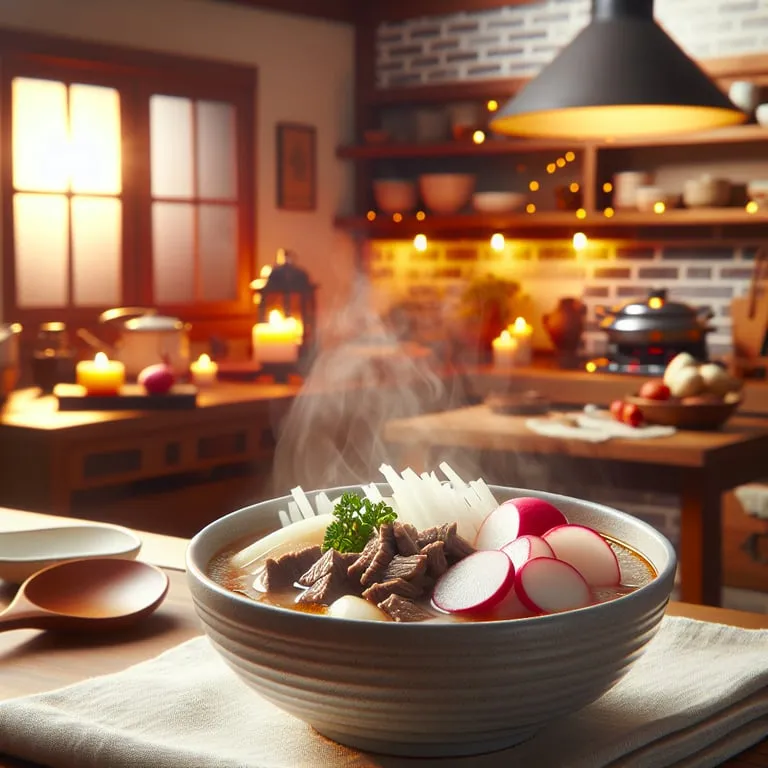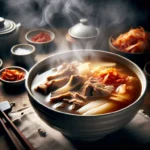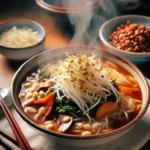Imagine stepping into a world where warmth meets comfort, all wrapped up in a delightful bowl of Traditional Korean Beef Radish Soup, known as Soegogi Mu Guk. This beloved dish is more than just food; it’s a story simmered in rich flavors and cherished memories. The harmony of tender beef and crisp radish creates a symphony for your taste buds, inviting you to unwind and savor each spoonful. As you embark on this culinary journey, prepare to uncover the secrets behind this exquisite recipe, transforming simple ingredients into a heartwarming masterpiece. Let’s dive into the essentials that will make your soup a true delight!

Ingredients You’ll Need
To embark on your delicious journey of crafting Traditional Korean Beef Radish Soup (Soegogi Mu Guk), it’s vital to gather all the right ingredients. This not only enriches the flavors but also preserves the authenticity of this beloved dish! Let’s explore what you’ll need to create this culinary masterpiece!
1. Beef
You will need about 500 grams (1.1 pounds) of beef brisket or shank, which will impart a deep, rich flavor to the broth. The tenderness of the meat is essential for that melt-in-your-mouth experience! Consider using grass-fed beef for a healthier option, enhancing both the taste and nutritional value!
2. Radish
The star vegetable of this soup is the Korean radish, known as mu. Aim for approximately 300 grams (10.5 ounces), diced into bite-sized pieces. Korean radish has a slightly sweet and peppery flavor, adding a unique twist that complements the beef beautifully. Don’t skimp on this ingredient—it’s truly the soul of the dish! 🥬✨
3. Onions
You will need 1 medium onion, sliced. This ingredient adds sweetness and depth to the broth, helping to create that balanced flavor profile everyone loves. Feel free to throw in some green onions as well, as they contribute fresh notes and a pop of color! 🌱
4. Garlic
A must-have for this recipe is 5 cloves of garlic, minced. Garlic not only enhances the flavor but also offers a health boost with its rich antioxidant properties. Who knew that something so delicious could be so good for you? 😉
5. Soy Sauce
Using around 3 tablespoons of soy sauce will bring a savory dimension to your soup. Opt for low-sodium soy sauce if you’re mindful of salt intake, ensuring you can control the flavor while staying health-conscious!
6. Sesame Oil
Around 1 tablespoon of sesame oil will introduce a nutty aroma, taking your soup to the next level! It’s that secret ingredient that elevates simple dishes to gourmet experiences!
7. Pepper and Salt
Seasoning is key! You’ll want to have black pepper and salt handy to taste, allowing you to refine the flavors to your liking. Remember, a well-seasoned dish is a happy dish! 🎉
8. Water
Finally, about 6 cups of water will serve as the base for your broth. The quality of the water will influence your soup, so filtered water is often the best choice to achieve that clear, savory liquid everyone will adore!
Each of these ingredients plays an instrumental role in creating the warmth and comfort that comes from a hearty bowl of Soegogi Mu Guk. As you prepare to cook, take a moment to appreciate the freshness and vibrancy of these elements! 🌈
With everything ready, you are now equipped to dive into the cooking process! Excitement is in the air as you prepare to transform these ingredients into a soul-warming bowl of comfort! 🍲✨
Step-by-Step Cooking Instructions
To create a delightful bowl of Traditional Korean Beef Radish Soup (Soegogi Mu Guk), let’s embark on a culinary adventure together! 🥢 With careful attention to detail, this recipe promises flavors that dance on your palate and warmth that embraces your soul. Here’s how to craft this remarkable dish with precision and flair:
1. Prep the Ingredients
Start by gathering everything you need. You’ll require 1 pound of beef (preferably brisket or chuck), 1 medium radish (mu), 4 cups of water, 1 tablespoon of soy sauce, 2 cloves of garlic minced, ½ teaspoon of salt (adjust to taste), and a dash of sesame oil for finishing. Don’t forget some green onions for garnish! 🌱
2. Beef Preparation
Carefully chop the beef into bite-sized pieces, ensuring uniformity for even cooking. Applying a sharp knife, you’ll want to slice against the grain, which results in more tender pieces. You can marinate the beef with a pinch of salt and 1 tablespoon of soy sauce for about 30 minutes. This step enhances the meat’s flavor and tenderness!
3. Sautéing Aromatics
In a large pot, pour in a drizzle of sesame oil over medium heat. Add the minced garlic and sauté for about 1 minute until fragrant. Aromatic garlic creates a lovely foundation for your soup, and the combination of warmth from the oil adds depth! 🌟
4. Cooking the Beef
Now, enter the marinated beef! Carefully add it to the pot, stirring frequently to sear the meat. Cook for about 5-7 minutes, until the beef is browned and tender. The sizzling sound and rich aroma is an announcement that something wonderful is happening! 💖
5. Incorporating the Radish
Once the beef is beautifully browned, it’s time to include the radish. Cut your radish into half-inch cubes and add them to the pot. Stir to combine, and let them mingle with the beef for an additional 3-4 minutes. The radish contributes a subtle sweetness and a crunchy texture that is just divine!
6. Simmering the Soup
Pour in 4 cups of water and bring the mixture to a boil. Once boiling, reduce the heat, cover, and let it simmer for 30 minutes. During simmering, the flavors will meld beautifully, and the radish will soften, releasing its essence into the broth. ☁️
7. Final Seasoning
After the 30 minutes have elapsed, taste your soup. Here’s where you get to play chef! Adjust the seasoning with more soy sauce or salt if it needs a little extra pizzazz. This is your moment to shape the final notes of the dish. For a delightful finish, drizzle a bit more sesame oil for an aromatic touch!
8. Garnish and Serve
It’s time to dish out this soul-soothing soup! Ladle the broth into bowls, ensuring each serving gets a generous amount of beef and radish. Garnish with finely chopped green onions. Just look at those vibrant colors! 🌈 It’s as pleasing to the eye as it is to the palate.
9. Enjoy Your Creation
Gather around the table, and feel the warmth of the soup seep into your very being. Pair it with warm rice or crispy kimchi for a delightful meal! Each spoonful is a comforting reminder of traditional flavors and home-cooked goodness.
This entire process may take slightly over an hour, but the end result is profoundly rewarding. With each carefully executed step, you are building not just a meal, but also connections—whether with family, friends, or your own delightful self. The essence of Soegogi Mu Guk will surely resonate within!
Tips for Perfecting the Soup
When it comes to crafting the perfect Soegogi Mu Guk, attention to detail can elevate this traditional Korean dish from delightful to downright unforgettable! 🥢 To achieve that coveted depth of flavor and silky texture, here are some invaluable tips that will guide you through the process.
Choosing the Right Beef
First and foremost, the choice of beef is crucial. Opt for a well-marbled cut such as chuck or brisket, ideally aged for at least 21 days! This enhances the umami profile of the meat, making every bite a flavor explosion! 🌟 When you sauté the beef, don’t rush it! Let it sear on high heat for about 5-7 minutes, allowing those beautiful caramelized bits to form at the bottom of your pot. This Maillard reaction is where the magic happens, infusing the broth with additional richness!
Selecting the Perfect Radishes
Now, let’s talk about radishes! The Korean radish (mu) is the star in this dish, and selecting the freshest, crispest radish is non-negotiable. Look for ones that are firm and heavy, as they will lend a beautiful crunch and vibrant flavor to the soup. When prepping your mu, cut it into large chunks—this will allow it to hold up during the cooking process and not turn mushy! A bite of tender yet firm radish is truly something special!
Creating a Delicious Broth
Don’t forget the broth! Using a combination of beef stock and water can create a deliciously complex base. A ratio of 2:1 beef stock to water will do the trick wonderfully. A simmer time of around 45 minutes is advisable—this allows the flavors to meld beautifully. But here’s a secret: for an even deeper flavor, consider adding a small piece of dried kelp (dashima) to the pot during the simmering stage! Remove it just before serving for an umami boost without overwhelming the dish. 🍜
Perfecting the Seasoning
Seasoning is key. As a golden rule, remember to taste and adjust as you go! Use about 1 tablespoon of salt initially, then build on that by gradually adding soy sauce (approximately 2-3 tablespoons) until you hit the flavor balance that suits your palate. Additionally, freshly cracked black pepper adds a delightful kick!
Enhancing the Aroma
To enhance the aroma, consider finishing your soup with roasted sesame oil and a sprinkle of green onions. A teaspoon of the oil drizzled just before serving can add a wonderful nuttiness. Why not also add a pinch of red pepper flakes for some heat? It’ll not only spice things up but also create a beautiful visual contrast! 🌶️✨
The Importance of Patience
Lastly, remember that patience is key! Allow the soup to sit for at least a few minutes after cooking. This resting time lets the flavors marry! If you’re serving it later, consider cooling it down first before refrigerating. Reheating not only makes the soup easier to serve but also enhances the taste even further. Yes, soups often taste better the next day! What a delightful thought, isn’t it? 😊
By focusing on these tips and employing a bit of culinary creativity, your Soegogi Mu Guk will not only warm the body but also the heart. Should you dare to take a more adventurous route, consider adding mushrooms or glass noodles to the mix. The world of flavors is limitless when it comes to this exceptional dish! So why not put on your apron and let the cooking journey begin? 🥦🍖✨
Serving Suggestions and Variations
When it comes to enjoying the exquisite flavors of Traditional Korean Beef Radish Soup (Soegogi Mu Guk), serving suggestions and variations can elevate your dining experience to new heights! Let’s explore some creative and delightful ways to serve this comforting dish, ensuring that every bowl is a flavorful adventure.
Accompaniments for the Soup
First, consider the ideal accompaniments. A classic pairing is a bowl of freshly steamed short-grain rice, famed for its sticky texture, allowing each grain to soak up the rich broth. Typically, a serving size is about 1 cup (150g) per person, which harmonizes beautifully with the soup, providing balance and satisfaction. Don’t forget the kimchi! A side of spicy, fermented cabbage or radish kimchi adds an irresistible crunch and a sharp contrast to the mellow flavors of the radish soup – a must for authentic Korean dining! 🌶️🥬
Creative Variations
For those who love to experiment, variations of this dish can be an exciting exploration! Imagine adding a touch of gochugaru (Korean red pepper flakes) to spice things up a notch! A teaspoon (5g) can transform the bowl into a warm, spicy delight. Alternatively, for a unique twist, consider including other vegetables, such as sliced shiitake mushrooms or zucchini. Adding these ingredients not only enhances the texture but also increases nutritional value. Each ounce (28g) of mushrooms packs a punch with nutrients, adding umami to the broth. 🍄🥒
Fun Serving Ideas
If you’re feeling adventurous, you might wish to serve the soup with a poached egg on top! The richness of the egg yolk oozing into the soup creates a velvety texture that is simply sublime. Each egg brings approximately 6 grams of protein, making your meal more filling and nutritionally balanced. Also, don’t shy away from garnishing with fresh herbs such as chopped green onions or cilantro! These herbs lend a fresh and aromatic touch that can take your bowl from ordinary to extraordinary. 🌿✨
Fusion Flavors
A delightful twist to consider is a fusion twist of flavors! Try incorporating some Thai basil and a hint of lime for a refreshing spin that dances on your taste buds. The zest from the lime will awaken the other flavors in the soup, while Thai basil adds an aromatic sweetness that elevates the entire dish. 🍋🌱
Hearty Substitutions
For those who prefer heartier versions, feel free to substitute beef with pork or chicken! Using 500 grams of pork shoulder or chicken thighs can create a new flavor profile while maintaining the essence of this traditional dish. The beauty of this recipe lies in its adaptability, allowing you to cater to different tastes while keeping the core warmth of the soup intact. 🥩🍗
Serving Method
Lastly, consider serving Soegogi Mu Guk in individual stone bowls (ttukbaegi). This method not only keeps the soup warmer for longer periods but also adds a rustic presentation that is truly appealing! Food served in stoneware often whispers elegance while allowing the flavors to meld beautifully.
Each of these serving suggestions and variations invites creativity to your kitchen while honoring the integrity of traditional Korean flavors. With simple additions or substitutions, you can make this delightful dish uniquely yours, ensuring that every spoonful is an explosion of comfort and richness! Enjoy the culinary journey and the delightful experience that comes with sharing a lovely bowl of Soegogi Mu Guk, whether around the dining table with loved ones or on a cozy solo evening! 🍲❤️
As you embark on your culinary journey with Traditional Korean Beef Radish Soup, let the flavors dance on your palate and the aromas envelop your kitchen. Each bowl serves not just as a meal, but a warm hug from generations past, beckoning you to savor the moments shared over food. Remember, perfection lies in customization; don’t hesitate to make it your own. As you serve this delightful dish, envision new stories unfolding, inviting loved ones to gather, their laughter harmonizing with the rich broth. May each spoonful remind you of the simple joys of home and hearth. Happy cooking!













